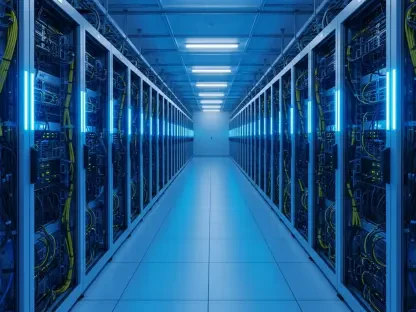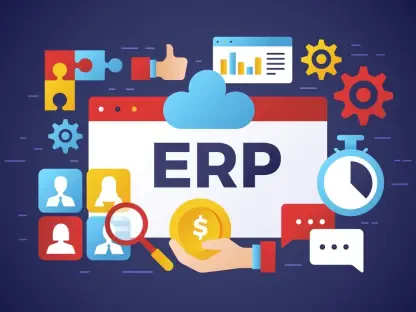The Semiconductor Industry in the AI ErAn Overview
Imagine a world where every digital interaction, from voice assistants to autonomous vehicles, hinges on a tiny chip’s ability to process vast amounts of data in milliseconds, shaping the very foundation of our technological landscape. This is the reality of the semiconductor industry today, a cornerstone of global technological advancement that powers everything from consumer electronics to cutting-edge artificial intelligence systems. The industry stands at a pivotal moment, with its products enabling transformative innovations across sectors, while facing intense pressure to keep pace with exponential demand. Semiconductors are no longer just components; they are the lifeblood of the digital economy, shaping how industries evolve in an increasingly connected world.
At the heart of this transformation lies artificial intelligence, often referred to as the catalyst of an “AI supercycle.” This phenomenon is redefining industry dynamics by driving unprecedented needs for specialized hardware, faster processing, and robust infrastructure. AI’s insatiable appetite for computational power is pushing companies to innovate at breakneck speed, creating a ripple effect that influences chip design, manufacturing processes, and even geopolitical strategies. The result is a landscape where adaptability and foresight determine market leadership, as firms scramble to align with AI’s trajectory.
Key segments like chip design, memory solutions, and high-performance computing infrastructure are experiencing significant shifts to meet AI demands. Major players such as Nvidia, AMD, TSMC, and Samsung are not only competing but also redefining their roles within this ecosystem. Nvidia dominates AI accelerators, while TSMC solidifies its position as a manufacturing powerhouse. Meanwhile, geopolitical tensions and technological breakthroughs, such as advanced node processes, continue to shape strategic decisions, compelling companies to navigate a complex web of innovation and global policies with precision.
AI as the Catalyst for Industry Consolidation
Key Trends Fueling Mergers and Alliances
The surge in demand for AI-specific hardware, such as specialized chips and High-Bandwidth Memory, is a primary driver behind the wave of mergers and strategic partnerships in the semiconductor sector. Companies are racing to secure capabilities that support the computational intensity of large language models and edge AI applications. This rush has led to a flurry of activity, as firms recognize that staying ahead requires not just innovation but also scale and integration, prompting them to join forces or acquire complementary technologies.
A notable trend is the shift toward vertical integration, where businesses aim to control full-stack solutions encompassing hardware, software, and infrastructure. This approach allows for seamless optimization of AI systems, reducing dependency on external partners and enhancing competitive edges. For instance, firms are increasingly looking to combine chip design with software ecosystems, ensuring that their offerings are tailored to specific AI workloads, a move that reshapes traditional industry boundaries.
Emerging technologies like advanced packaging and AI-enabled design tools further accelerate consolidation, as do market needs in niche areas such as automotive AI and hyperscale data centers. Collaborations and acquisitions are opening doors to these specialized segments, enabling companies to tap into new revenue streams. As AI continues to permeate diverse applications, the strategic imperative to form alliances or merge becomes not just a choice but a necessity for survival and growth.
Market Growth and Future Projections
Current data underscores the semiconductor industry’s robust expansion, fueled by AI-driven demand, with market size projected to grow significantly over the next few years. Industry reports indicate substantial investments flowing into AI accelerators and memory solutions, with key players posting notable revenue increases. This growth trajectory reflects a broader trend of heightened capital allocation toward technologies that underpin AI’s computational backbone, signaling strong confidence in sustained demand.
Looking ahead, forecasts suggest a continued rise in customized AI hardware, with specialized accelerators and memory technologies expected to see double-digit growth rates through 2027. Deals like Synopsys’s acquisition of Ansys highlight the economic impact of strategic consolidation, enhancing capabilities in simulation and design automation critical for AI chip development. Such transactions are poised to redefine market share, positioning leading firms to dominate emerging segments while challenging smaller competitors.
The long-term outlook points to consolidation shaping competitive positioning, as larger entities leverage economies of scale and integrated portfolios to outpace rivals. Revenue metrics from industry giants indicate that strategic mergers are not merely additive but multiplicative in their impact, creating synergies that amplify market influence. As these trends unfold, the balance of power within the sector will likely tilt further toward those who can execute transformative deals effectively.
Challenges in Navigating the AI-Driven Semiconductor Landscape
The complexity of developing AI hardware brings significant challenges, particularly in managing increased system integration and meeting stringent technical demands. Designing chips that power advanced AI models requires intricate coordination across multiple layers of technology, often straining resources and expertise. This intricacy pushes companies to rethink development pipelines, seeking ways to streamline processes while maintaining cutting-edge performance standards.
Supply chain vulnerabilities and geopolitical tensions add another layer of difficulty, prompting a push for friend-shoring and domestic manufacturing to ensure stability. Disruptions in global supply lines, coupled with trade restrictions, have exposed risks in over-reliance on specific regions, urging firms to diversify their operational bases. This shift, while strategically sound, introduces new costs and logistical hurdles that must be carefully balanced against the benefits of localized production.
Environmental concerns also loom large, with the high energy consumption of AI data centers drawing scrutiny. The industry faces pressure to innovate sustainably, balancing the drive for computational power with the need to reduce carbon footprints. Efforts are underway to integrate renewable energy sources and optimize efficiency, alongside initiatives to foster diversified partnerships and talent development, ensuring that growth does not come at the expense of long-term ecological or competitive health.
Regulatory and Geopolitical Influences on Industry Strategies
The regulatory landscape significantly impacts semiconductor mergers and partnerships, with trade policies and national security considerations playing central roles. Governments worldwide are tightening oversight on cross-border deals, particularly those involving critical technologies like AI hardware, to safeguard strategic interests. This scrutiny often delays or reshapes transactions, forcing companies to adapt their strategies to align with evolving compliance frameworks.
Initiatives to boost domestic production in regions such as the United States and Europe are reshaping global supply chains, aiming to reduce dependency on foreign manufacturing. These efforts, often backed by substantial government incentives, encourage localized operations but also fragment the industry, creating regional silos. The resulting dynamics compel firms to recalibrate their supply networks, balancing cost efficiency with policy-driven mandates.
Geopolitical fragmentation further influences alliances, as companies navigate data security and intellectual property challenges amid rising tensions. Restrictions and incentives from various governments dictate the pace and direction of consolidation, often pushing toward regional manufacturing bases. This evolving environment requires semiconductor players to remain agile, leveraging strategic partnerships and compliance expertise to mitigate risks while capitalizing on policy-driven opportunities.
Future Horizons: The Semiconductor Industry Post-AI Supercycle
The long-term trajectory of the semiconductor sector points to sustained demand for AI and high-performance computing solutions, even as the initial fervor of the AI supercycle matures. Industries ranging from healthcare to logistics will continue to rely on advanced chips for smarter, data-driven operations, ensuring that innovation remains a constant priority. This enduring need positions the sector for steady growth, provided it can address emerging challenges with foresight.
Emerging technologies, such as chiplet architectures and novel manufacturing approaches, promise to redefine production capabilities, potentially revolutionizing cost and performance metrics. Speculative ideas, like space-based production, while still distant, hint at the industry’s willingness to explore unconventional paths for breakthroughs. These advancements could unlock new frontiers, provided they overcome technical and economic barriers in the coming years.
Consumer and enterprise preferences for AI-driven applications will further drive market evolution, with potential disruptors like quantum computing or geopolitical shifts adding layers of uncertainty. The interplay of innovation, regulatory changes, and global economic conditions will shape future investment opportunities, requiring stakeholders to remain vigilant. As these factors converge, the sector’s ability to adapt will determine which growth areas emerge as dominant in the post-supercycle era.
Synthesizing the Impact of AI on Semiconductor Consolidation
Reflecting on the insights gathered, it becomes evident that AI has driven an unparalleled wave of mergers, acquisitions, and strategic alliances within the semiconductor industry. This transformation has offered immense potential for innovation, positioning hardware as a critical pillar of AI’s evolution, while simultaneously presenting challenges such as market concentration and sustainability. The dual nature of this shift underscores the need for careful navigation to ensure equitable progress across the sector.
Looking ahead, actionable steps emerge as essential for industry stakeholders. Fostering smaller innovators through targeted partnerships appears as a viable way to maintain competitive diversity, while prioritizing sustainable practices through investments in energy-efficient technologies promises to address environmental concerns. Additionally, expanding collaboration in talent development and supply chain diversification stands out as critical measures to build resilience against geopolitical and operational risks.
Ultimately, the path forward suggests a focus on balanced growth strategies, with an emphasis on integrating ethical considerations into technological advancement. Potential areas for investment, such as next-generation memory solutions and regional manufacturing hubs, offer promising avenues for long-term stability. By embracing these opportunities and maintaining a commitment to adaptability, the industry can solidify its role as a cornerstone of the AI-driven future.









